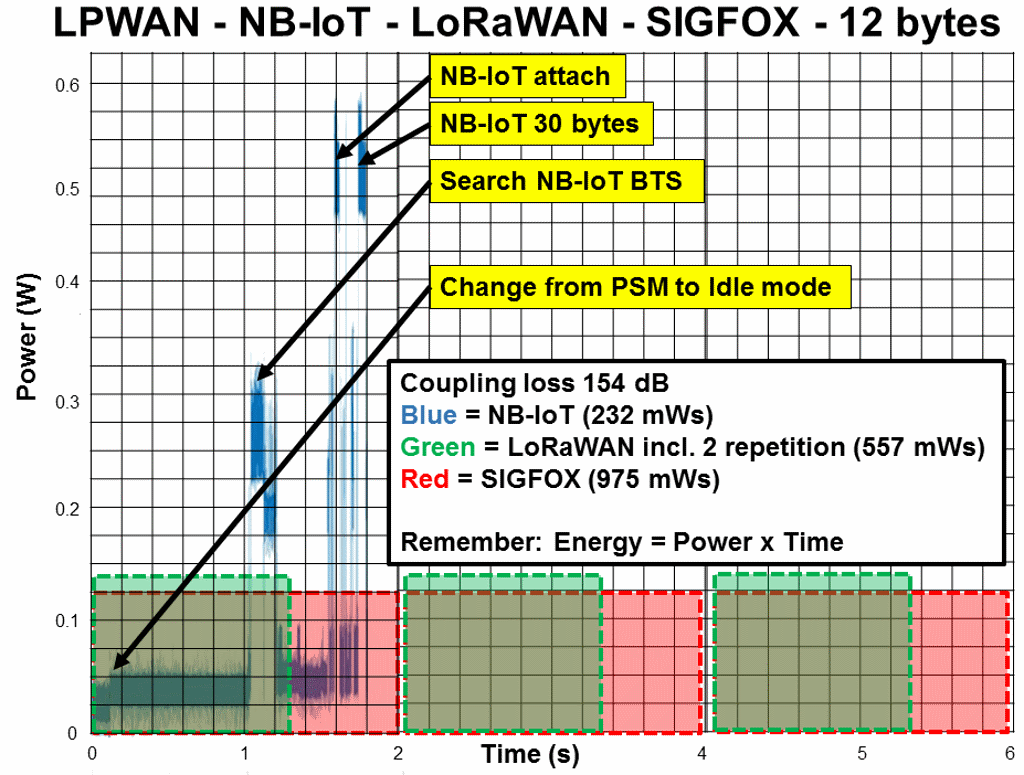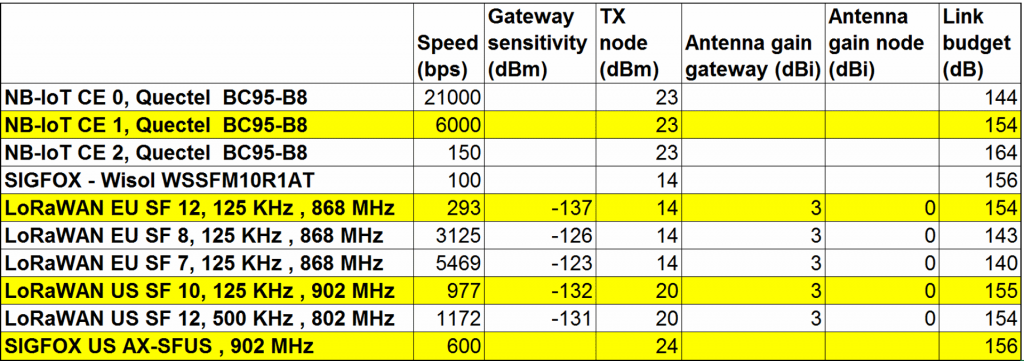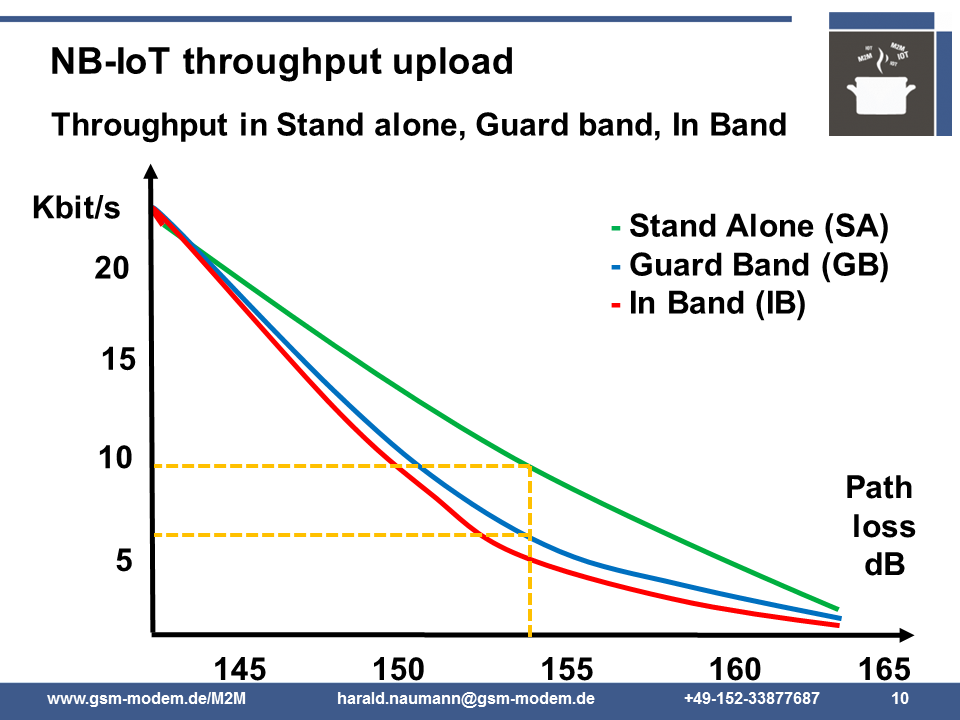The energy consumption of a radio transmitter is computed by multiplying the power output with time. The graph clearly shows the envelope of various LPWA transmitters in Europe over time. In Europe SIGFOX and LoRaWAN are limited to 14 dBm TX power. SIGFOX and NB-IoT are along the right scale of time axis. However, in reality, the repetitions for LoRaWAN will not happen within such a short time. After 1 % on TX, the LoRaWAN module will wait for 99 % of the time unit. In the example shown on the graphic, 1.25 seconds of TX will be followed by 123.75 seconds of waiting. The three data packages including wait time will need 1.25 seconds x 3 + 123.75 seconds x 2 = 251.25 seconds (4 minutes and 18.25 seconds). We used 12 bytes in this comparison because SIGFOX is not able to transmit more than 12 bytes in per message. We selected 154 dB link budget, because the maximum link budget for SIGFOX in EU is 156 dB. 154 dB link budget is the specified in NB-IoT CE level 1. In NB-IoT we have three coverage enhancement (CE) levels specified. CE level 0 corresponds to normal coverage, and CE level 2 to the worst case, where the coverage may be assumed to be poor. 154 dB link budget is the maximum realstic link budget for LoRaWAN with a 3 dBi gain antenna at the gateway. A higher antenna gain like 5 dBi makes no sense, because then the antenna gain angle get small. We used Quectel BC95-B8 (NB-IoT), Acsip S76S (LoRaWAN) and Wisol WSSFM10R1AT (SIGFOX) for comparision because those modules have a big footprint in the market.
LoRaWAN link budget calculated
SIGFOX
SIGFOX has a purely static transmission protocol. With SIGFOX, a message with a maximum cap of 12 bytes will be repeated three times. The transmission power or the speed of the data transmission is fixed at 100 bps and can not be adjusted. Even when the device is in the immediate neighborhood of the gateway, approximately 1000 mWs of energy are used repeatedly. A check for accessibility to a gateway does not take place for 2,500,000 SIGFOX devices shipped until March 2018. A possible collision on the air interface will not overflow; the 1000 mWs will be spent even if the 12 bytes cannot arrive. An acknowledgement of all uploaded messages is not possible because the protocol of SIGFOX allows only four downlink messages with a maximum of eight bytes. The static SIGFOX protocol has a very high-energy consumption because neither communication speed nor TX power level can be adjusted. The new feature called Monarch will check for a beacon signal at the gateway. As soon new modules with the new feature will be available the energy consumption will get better. However, the three static repeations are still left because their sno acklowledgement of packages.
LoRaWAN
LoRaWAN is one of many radio protocols on the physical layer LoRa. A LoRaWAN base station does not send any beacon signal and is called a gateway. LoRaWAN also does not allow a check whether other LoRaWAN base stations are nearby. If an acknowledgment fails, the speed of the transmission is changed and sent again. The number of unsuccessful iterations is proportional to the unnecessary energy consumption. If an acknowledgment mode is activated, the device generally acknowledges the gateway with the highest RX level. For immovable objects, a new transmission is sent at the rate of the last successful transmission. LoRaWAN tries to send the 12 bytes as fast as possible in order to optimize for the energy consumption. As LoRaWAN transmissions are asynchronous in nature, collisions on the air interface are likely. In addition, in the unlicensed spectrum band, other unknown participants that are asynchronous in the same radio channel can cause interference. At 154 dB link budget (151 dB sensitivity of the gateway plus 3 dB antenna gain) and with a message size of 12 bytes, LoRaWAN occupies the channel for 1.25 seconds. With a longer time, the probability of a collision increases. Therefore, three repetitions are assumed. At its maximum throughput, the worst-case scenario leads to five repetitions. If five repetitions need to happen then it will result in several minutes of delay for the delivery of a simple alarm message.
NB-IoT
With NB-IoT the communication is synchronized. An NB-IoT module will check the presence of a base station before sending the message. Unnecessary transmissions are thus avoided. NB-IoT uses TDMA and transmits in defined time slots in the licensed spectrum band. A collision with unknown participants is thus entirely avoided. NB-IoT regulates the transmission speed based on the bit error rate. The error rate increases as with all radio systems with the distance to the base station. With repetitions in the transmission and consequently longer airtime, the errors are figured out and corrected. Unlike LoRaWAN and SIGFOX, the maximum link budget of NB-IoT is up to 164 dB. However, at 164 dB, however multiple repetitions are necessary. The net communication speed at 164 dB is estimated at 150 bps. The NB-IoT network in Dresden, Germany, is planned for an estimated 154 dB coupling loss with deep indoor coverage. To sum up, NB-IoT is an intelligent protocol that avoids collisions and prevents unnecessary transmission. In addition, the NB IoT can transfer from one byte to several hundred bytes within one message container. With SIGFOX one message is limited to 12 bytes. LoRaWAN is capped at 148 to 154 dB (SF10, SF11, SF12) and limited to 38 bytes of data in addition to 13 bytes header. Longer messages like 50 to 200 bytes with LoRaWAN and SIGFOX must be split into several smaller messages, and as a result require a message header with counter. The server has to put it all together and request the missing messages again. In addition, with multi-frames, the header of 12 bytes or 13 bytes must be rep
eated at LoRaWAN and SIGFOX. This effort and energy loss will not occur with the NB-IoT network.
NB-IoT troughtput and path loss
Slide number 10 out of the presentation “Comparsion of LPWAN like “NB-IoT, Weightless, LoRaWAN & SIGFOX”.
Collusion of the LPWAN comparision
SIGFOX is static at 100 bps and repeats statically three times and does not control either TX power or speed.
LoRaWAN transmits at 154 dB coupling loss with 293 bps (say ~300 bps), and with three repetition it leaves out about 100 bps at the end. Transmission without repetitions will only work on standalone trial with few participants and is not typical of the field setup. With increasing numbers, the collisions will continue to rise. At maxium troughput an Aloha based protocol will have a package loss of 82%. At 154 dB coupling loss NB-IoT has a transmission rate of 6000 bps net. The repetitions are already deducted in the 6000 bps calculation. That is the reason why NB-IoT only needs 1.8 seconds for 12 bytes (although it shows as 30 bytes on the graphic). The UDP header is also included in the 30 bytes. If you transfer to Non-IP, even the energy to transmit the UDP header will be saved. NB-IoT is extremely dynamic and has no common problems as expected in the unlicensed band. NB-IoT is on TDMA and will avoid package losses by a time synchronised communition. The winner in comparison of transmitting of 12 byte on 154 dB coupling loss is NB-IoT.
Criticism of NB-IoT
The critics of NB-IoT among people working with module manufactures, operators or Alliances in the unlicensed band keep repeating the same topics. It starts with the repetitions at NB-IoT. Repetitions are in use on all named LPWA techniques to compensate for packet loss or bit error rate. NB-IoT supports up to 164 dB coupling loss. This is physically impossible with LoRaWAN or SIGFOX. In addition, the transmission time in Europe at 14 dBm TX and Aloha-based systems is limited to 1 % per hour. SIGFOX always repeats three times and always transmits at 100 bps in Europe. NB-IoT has a dynamic range from 100 bps to 21 kbps. With bundling of NB-IoT channels, attaining over a communication speed of 252 kbps is possible.
A further criticism are the peak currents of about 200 mA at 23 dBm at NB-IoT. However, with SIGFOX in USA peak currents are similar at 200 mA at 23 dBm TX. For LoRaWAN, the power needed at 20 dBm is already 125 mA and for 3 dB more we double this to 250 mA. Remember, energy is defined as Voltage per Ampere per time. The peak currents say nothing at face value. The area under the envelope decides the discharge of the battery.
With a high link budget, NB-IoT increases the time to connect. It takes longer to detect the NB-IoT base station. Nevertheless, it also takes longer for channels to be allocated. Searching the base station costs energy. Waiting and doing nothing consumes little energy compared to sending and receiving. The envelope shows this power-usage dynamics within its different phases of from wake up (change from PSM mode) to receiving (search for BTS), attach to BTS and short burst to transmit the 30 bytes of data.
Many of the critics come from countries without NB-IoT coverage. These critics cannot even test whether NB-IoT is better or worse. Other critics are employed by the manufacturer or network operator (SIGFOX, LoRaWAN) and therefore cannot offer a free, honest opinion. Others again only repeat and copy third-party text and graphics without checking the text and images. The NB-IoT network operators do not help the cause. They often list just the minimum and maximum parameters summarized in their tables. Yes, NB-IoT can offer 21 kbps per channel and bundling of channels makes transmission ultra-fast in comparison to LoRaWAN and SIGFOX but does this speed really benefit your application? If you engage comparisons, then you should also compare apples with apples and set the coupling loss to 154 dB. With LoRaWAN you cannot ignore the necessary repetitions and name energy consumption for one data packet only.
Next possible topics to compare:
- Energy consumption at 50 byte, 200 bytes and 512 bytes on NB-IoT, LoRaWAN and SIGFOX
- Energy consumption during sleep on NB-IoT, LoRaWAN and SIGFOX
- Energy consumption during receiving acknowledge or download of 12 bytes, 50 bytes, and 512 bytes on NB-IoT, LoRaWAN and SIGFOX
- Energy consumption during reattach and new attach on NB-IoT, LoRaWAN and SIGFOX
- Energy consumption during 100 KB firmware update on NB-IoT, LoRaWAN and SIGFOX
- Comparison of packages from 12 byte up to 512 byte on NB-IoT, LoRaWAN and SIGFOX
- Security of LPWAN on NB-IoT, LoRaWAN and SIGFOX
- Pricing for the subscription on NB-IoT, LoRaWAN and SIGFOX
- Capacity per km2 on NB-IoT, LoRaWAN US, LoRaWAN EU and SIGFOX
I hope that this short article will motivate you to think about which LPWAN will best fit your application. If you still cannot reach conclusion based on this information and need some advice or consulting then do not hesitate to drop an email to harald.naumann (at) lte.modem.com . I am working on my new IoT / M2M Cookbook related to LPWAN and I can offer you all the above mentioned LPWAN technologies (modules, antennas, base stations). Thank you in advance for your comments at the blog or ping me an email.



Hi Harald Naumann;
May I ask you a question.
In the picture, you said, the Sigfox power consumption is 975mWs. But why. I think it should be 125mW*6s = 750mWs.
Thank you very much indeed.
B.R
Andy
Hi Andy, the calculation is based on the Wisol SIGFOX module with the OnSemi Chip Set. In the data sheet of the chipset there are even more than 1000 mWs.
For NB-IoT with 154 dB link budget it was 480 mWs and for 144 dBm only 280 mWs.
With LoRaWAN there is much more than in the work. -137 dBm can only be achieved in the laboratory. The noise level in German cities is approx. 100 dBm. With SF12 you get 20 dB below the noise level. -120 dBm is approximately the best value. 27 dBm TX + -120 dBm + 2 + 2 = 151 dB LB in the upload and 14 dBm TX + 2 + (-120 dBm) + 2 dBm gives link budget of 138 dB in the upload. More about this later in the new LPWAN Cookbook.